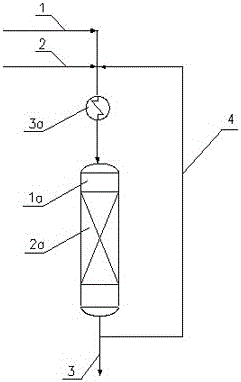The method for the epoxidation of cumene hydrogen peroxide and propylene
A technology of cumene hydrogen peroxide and epoxidation, applied in chemical recovery, organic chemistry and other directions, can solve problems such as reaction temperature rise, and achieve the effect of reducing reaction temperature rise and improving selectivity
- Summary
- Abstract
- Description
- Claims
- Application Information
AI Technical Summary
Problems solved by technology
Method used
Image
Examples
Embodiment 1
[0030] according to figure 1Shown technical scheme, raw material contains the cumene hydroperoxide mixture of 35% weight concentration, and flow rate is 101166.1 kilogram / hour, raw material propylene 10812.7 kilogram / hour, circulating propylene 92993.1 kilogram / hour, and the circulating ring of 136648.1 kilogram / hour The oxidation reaction products are mixed, and enter a single-bed adiabatic fixed-bed reactor at a reaction temperature of 55 °C and a reaction pressure of 3.1 MPaG, and Ti / SiO 2 Catalyst contact, liquid phase epoxidation reaction produces propylene oxide and dimethyl benzyl alcohol and other by-products. Cumene hydroperoxide weight space velocity 4.5hr -1 , the molar ratio of total propylene to cumene hydroperoxide is 10.2, the molar ratio of propylene to cumene hydroperoxide at the catalyst bed inlet reaches 16.3, the reactor outlet temperature is 85.8°C, and the cumene hydroperoxide The overall conversion of benzene was 99.4% and the molar selectivity to prop...
Embodiment 2
[0032] Same as [Example 1], only the flow rate of circulating propylene is changed: the circulating propylene flow rate is 61995.4 kg / hour, and others are the same as [Example 1]. Cumene hydroperoxide weight space velocity 4.5hr -1 , the molar ratio of total propylene to cumene hydroperoxide is 7.1, the molar ratio of propylene to cumene hydroperoxide at the catalyst bed inlet reaches 11.2, the reactor outlet temperature is 89.2°C, and the cumene hydroperoxide The overall conversion of benzene was 99.4%, and the molar selectivity to propylene oxide was 96.0%.
Embodiment 3
[0034] Same as [Example 1], only the reactor form is changed: a two-bed adiabatic fixed-bed reactor, and the others are the same as [Example 1]. Cumene hydroperoxide weight space velocity 4.5hr -1 , the molar ratio of total propylene to cumene hydroperoxide is 10.2, the molar ratio of propylene to cumene hydroperoxide at the catalyst bed inlet reaches 16.3, the reactor outlet temperature is 85.8°C, and the cumene hydroperoxide The overall conversion of benzene was 99.4% and the molar selectivity to propylene oxide was 96.2%.
PUM
 Login to View More
Login to View More Abstract
Description
Claims
Application Information
 Login to View More
Login to View More - R&D
- Intellectual Property
- Life Sciences
- Materials
- Tech Scout
- Unparalleled Data Quality
- Higher Quality Content
- 60% Fewer Hallucinations
Browse by: Latest US Patents, China's latest patents, Technical Efficacy Thesaurus, Application Domain, Technology Topic, Popular Technical Reports.
© 2025 PatSnap. All rights reserved.Legal|Privacy policy|Modern Slavery Act Transparency Statement|Sitemap|About US| Contact US: help@patsnap.com

